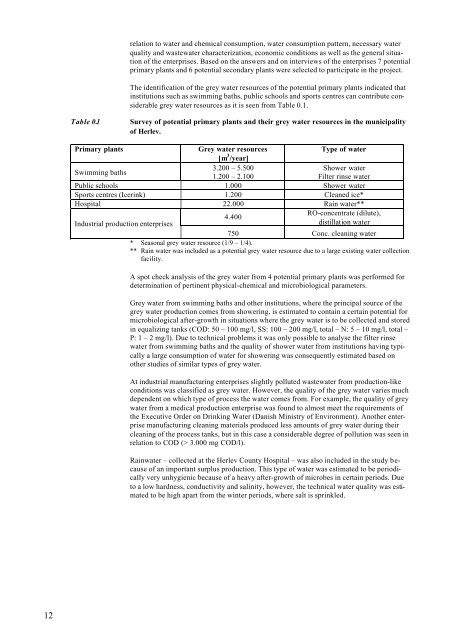PDF-format - Miljøstyrelsen
PDF-format - Miljøstyrelsen
PDF-format - Miljøstyrelsen
You also want an ePaper? Increase the reach of your titles
YUMPU automatically turns print PDFs into web optimized ePapers that Google loves.
12<br />
relation to water and chemical consumption, water consumption pattern, necessary water<br />
quality and wastewater characterization, economic conditions as well as the general situation<br />
of the enterprises. Based on the answers and on interviews of the enterprises 7 potential<br />
primary plants and 6 potential secondary plants were selected to participate in the project.<br />
The identification of the grey water resources of the potential primary plants indicated that<br />
institutions such as swimming baths, public schools and sports centres can contribute considerable<br />
grey water resources as it is seen from Table 0.1.<br />
Table 0.1 Survey of potential primary plants and their grey water resources in the municipality<br />
of Herlev.<br />
Primary plants Grey water resources<br />
[m 3 /year]<br />
Type of water<br />
Swimming baths<br />
3.200 – 5.500<br />
1.200 – 2.100<br />
Shower water<br />
Filter rinse water<br />
Public schools 1.000 Shower water<br />
Sports centres (Icerink) 1.200 Cleaned ice*<br />
Hospital 22.000 Rain water**<br />
Industrial production enterprises<br />
4.400<br />
RO-concentrate (dilute),<br />
distillation water<br />
750 Conc. cleaning water<br />
* Seasonal grey water resource (1/9 – 1/4).<br />
** Rain water was included as a potential grey water resource due to a large existing water collection<br />
facility.<br />
A spot check analysis of the grey water from 4 potential primary plants was performed for<br />
determination of pertinent physical-chemical and microbiological parameters.<br />
Grey water from swimming baths and other institutions, where the principal source of the<br />
grey water production comes from showering, is estimated to contain a certain potential for<br />
microbiological after-growth in situations where the grey water is to be collected and stored<br />
in equalizing tanks (COD: 50 – 100 mg/l, SS: 100 – 200 mg/l, total – N: 5 – 10 mg/l, total –<br />
P: 1 – 2 mg/l). Due to technical problems it was only possible to analyse the filter rinse<br />
water from swimming baths and the quality of shower water from institutions having typically<br />
a large consumption of water for showering was consequently estimated based on<br />
other studies of similar types of grey water.<br />
At industrial manufacturing enterprises slightly polluted wastewater from production-like<br />
conditions was classified as grey water. However, the quality of the grey water varies much<br />
dependent on which type of process the water comes from. For example, the quality of grey<br />
water from a medical production enterprise was found to almost meet the requirements of<br />
the Executive Order on Drinking Water (Danish Ministry of Environment). Another enterprise<br />
manufacturing cleaning materials produced less amounts of grey water during their<br />
cleaning of the process tanks, but in this case a considerable degree of pollution was seen in<br />
relation to COD (> 3.000 mg COD/l).<br />
Rainwater – collected at the Herlev County Hospital – was also included in the study because<br />
of an important surplus production. This type of water was estimated to be periodically<br />
very unhygienic because of a heavy after-growth of microbes in certain periods. Due<br />
to a low hardness, conductivity and salinity, however, the technical water quality was estimated<br />
to be high apart from the winter periods, where salt is sprinkled.

















